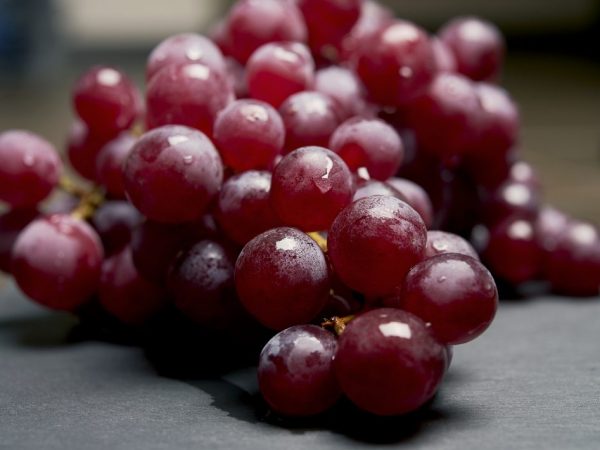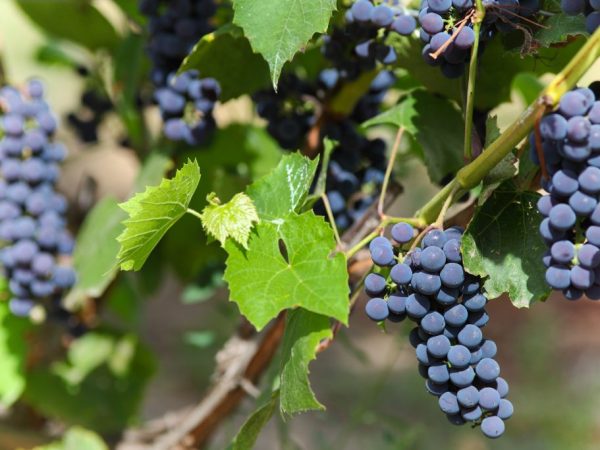Grape varieties from America
American grapes appeared in the 18th century. He has hybrids of different breeding, which are suitable for growing in different climatic conditions. The culture is resistant to frost and disease. America's grapes are used for fresh food and also in the preparation of drinks.

Grape varieties from America
Growing grapes in America
Grapes in America are grown for cooking:
- dried fruits (raisins and raisins);
- wine products;
- eating.
The culture is grown in:
- North Carolina;
- Michigan;
- Washington;
- Ohio;
- California.
Breeders annually breed different hybrids. More than 50 varieties are grown in California.
Description of culture
The varieties brought to America from Europe did not take root. They died out due to infections and fungus. To develop a sustainable and healthy vineyard, species from Europe and America were combined.
America's grapes in Russia are grown without difficulty: it is resistant to diseases and low temperatures. This culture can withstand -34 ° C.
The most comfortable conditions in the Russian Federation for the following American grape varieties:
- Berlandieri;
- Riparia;
- Rupestris;
- Monticola;
- Labrusca.
Riparia variety
The culture is medium in size, its leaves are large, pointed. The bunch is not large, the fruits are black, the flower is bisexual.
Riparia takes root either in clay soils or in sandy soils. The culture needs a lot of fertilizer. The presence of lime in the ground will lead to the extinction of the entire bush. The hybrid is resistant to various types of diseases. Riparia early ripening - ripening occurs in a period of up to 180 days under favorable climatic conditions.
Rupetris variety

The plant needs good lighting
Features of the Rupetris variety:
- grown in the South and in the Center of America;
- the growing area should be well lit;
- shoots spread in a creeping manner;
- vines darken after a year of growth;
- foliage is small.
The berry tastes like herb. The soil is suitable for clay and stony.
The variety takes root well in hot, dry climates. This selection is resistant to cold weather: it can withstand up to -28 ° C.
Berladieri variety
Hybrids of the species are grown in the south, north and center of America. Curly vines. The height of the shrub is average. The color of the one-year-old vine is brown. The foliage is small. The bunches can be of different sizes, the berries are large, blue.
Unlike other American varieties, Berladieri takes root in soil containing a high percentage of lime. It is resistant to phylloxera. New seedlings are difficult to take root.
Labrusca and Monticola varieties
These varieties are similar to Rupetris. The difference is the liana-like type of shoot. The survival rate of the planting material is poor. In Russia, both species are used for vaccination.
The size of the vine is up to 27 cm. The color of the shoot is brown. The bunches are small, the fruits are black and round. The taste is reminiscent of strawberries.
These varieties are resistant to any climatic conditions.
Planting and leaving
Harvesting of planting material is carried out in the Spring period. For planting, shoots are used, on which up to 7 eyes are located.The diameter of the vine is up to 1.1 cm, the length is up to 40 cm. The healthier the seedling, the better the harvest.
At the first pruning in the spring, up to 8 buds are left. Within 2 months after planting, they are engaged in systematic loosening and watering. For American breeding, the most dangerous disease is powdery mildew - it is imperative to carry out prophylaxis against it.
If the climate is arid, mulching is done. During flowering, a small number of flowers are cut off: this increases the size of the bunch by 80%. Bushes are constantly examined in order to be able to detect disease or pest damage in time.
Cold-resistant varieties
This group of American selection is the most resistant to subzero temperatures.
| Variety | Color | Berry weight | Bunch weight | Sugar | Maturation |
| Seneca | White | up to 5 g | up to 300 g | 18% | Early autumn |
| Ontario | White | up to 3.5 g | up to 250 g | 20% | Early autumn |
| Buffalo | Blue, purple | up to 5 g | up to 500 g | 21% | Early autumn |
| Vulture | Dark blue | up to 4 g | up to 300 g | 25% | Early autumn |
| Bluebell | Dark blue | up to 3.5 g | up to 300 g | 19% | Early autumn |
Conclusion
There are more than 25 varieties of grapes from America, including raisin hybrids. All of them are cold-resistant and undemanding to care conditions. The technical features of planting are the same as those of domestic varieties.


